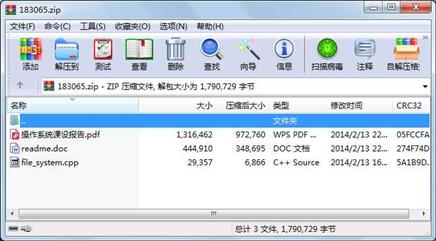资源简介
Requirements
1. Simulate a Unix file system on your Windows Platform
2. Understand the file system on Unix system, and the usage of i-nodes
3. Implement the function of sub-directory
4. The task needs to be completed using C++ or C
5.
Tasks/Functionalities
The following functions are required in your file system:
1. Allocate 16MB space in memory as the storage for your file system. The space is divided as
blocks with block size 1KB
Assume block address length is 32-bit;
Design the information contained in i-node
The i-node should support up to 10 direct block addresses
The i-node should support at least one indirect block address
2. The fist block is used for storing the i-node for the root directory(/). While your program is
lunched, two directories (/dir1 and / dir1/dir2) should be created, and also two files need to be
written as /dir1/file1 and /dir1/dir2/file2 (5 marks)
3. File 1 and 2 contain the message of “This is file 1.” and “This is file2”.
4. Following commands should be supported in your system:
a) Create a file:createFile fileName fileSize (10 marks)
i.e.:createFile /dir1/myFile 1024 (in bytes)
if fileSiz > max file size, print out an error message.
The file content is filled up with filename + repeated digits from 0 - 9
i.e.: “myFile012345678901234567890123….”
b) Delete a file:deleteFile filename (10 marks)
i.e.:deleteFile /dir1/myFile
c) Create a directory:createDir (5 marks)
i.e.:createDir /dir1/sub1
d) Delete a directory:deleteDir (5 marks)
i.e.: deleteDir /dir1/sub1 (The current working directory is not allowed to be
deleted)
e) Change current working direcotry:changeDir (5 marks)
i.e.: changeDir /dir2
f) List all the files and sub-directories under current working directory:dir (5 marks)
You also need to list at least two file attributes. (i.e. file size, time created, etc.)
g) Copy a file : cp (5 marks)
i.e.: file1 file2
h) Display the usage of storage space:sum (10 marks)
Display the usage of the 16MB

代码片段和文件信息
#include
#include
#include
#include
#include
using namespace std;
#define MAX_BLOCK 16*1024;//block的总数目
int systemUsed =1642;
struct USER_INF{
char user_id[22];
char pass_word[20];
};
struct BOOT_BLOCK{
USER_INF user_inf [3];
int user_sum;
int current_user;
};
struct SUPER_BLOCK{
int free_inode;
int free_data_block;
int total_data_block;
int first_data_block;
int first_inode_block;
int last_inode_block;
int inode_bitmap_block;
int data_bitmap_block;
int sizeof_block;
char cwdir[1024];
char usrdir[1024];
};
struct I_NODE{
int uid;
int lock;//0 can be delete1can;‘t delete
int read_only_flag;//0 can be for read and wirte 1 read only.
int type;//0 is directory 1 is data;
time_t create_time;
time_t modification_time;
time_t access_time;
int current_size;
int max_size;
int direct_addr[10];
int indirect_addr[2];
int shareDir;
int shareOffset;
};//100bytes
struct DATA_BIT_MAP{
bool data_bit_map[16*1024-1642];
};
struct INODE_BIT_MAP{
bool inode_bit_map[16*1024-1642];
};
struct INDIRECT_ADDR_BLOCK{
long addr[256];
};//1KB
struct DATA_BLOCK{
char content[1024];
};//1KB
//3是databit_map 2是inode_bitmap
struct DIRECTORY{
long inode_number;
char name[16];
};
struct DIRECTORY_BLOCK
{
char name[16];
DIRECTORY directory[50];
};
struct DISK{
BOOT_BLOCK *boot_block;
SUPER_BLOCK *super_block;
INODE_BIT_MAP *i_node_bit_map;
DATA_BIT_MAP *data_bit_map;
I_NODE *i_node;
//three types of the data blocks
INDIRECT_ADDR_BLOCK *in_addr;
DATA_BLOCK *data;
DIRECTORY_BLOCK *Dire_Block;
} *disk;//具体的block类型按需求赋值;
/*############################################*/
//help function!
int findFile_INode(long p char name[])//return file‘s inode
{
int pointer = -1;
time_t ti;
for(int i=0;i<50;i++)
{
if(strcmp(disk[p].Dire_Block->directory[i].namename) == 0)
{
pointer = disk[p].Dire_Block->directory[i].inode_number;
time(&ti);
disk[pointer].i_node->access_time = ti;
return pointer;
}
}
return pointer;
}
int findFreeINode()
{
for(int i= 0;itotal_data_block;i++)
if(disk[2].i_node_bit_map->inode_bit_map[i]==false)
return i+disk[1].super_block->first_inode_block;
}
int findFreeDataBlock()
{
for(int i= 0;itotal_data_block;i++)
if(disk[3].data_bit_map->data_bit_map[i]==false)
return i+systemUsed;
}
DIRECTORY_BLOCK* newDirectory()
{
DIRECTORY_BLOCK* temp = new DIRECTORY_BLOCK ;
for(int i=0;i<50;i++)
memset(temp->directory[i].name016);
return temp;
}
INDIRECT_ADDR_BLOCK* newINDIR_Addr()
{
INDIRECT_ADDR_BLOCK*temp = new INDIRECT_ADDR_BLOCK;
for(int i=0;i<256;i++)
temp->addr[i]=0;
return temp;
}
void assign_INode(int I)
{
time_t t;
time(&t);
disk[I].i_node->create_time =disk[I].i_node->access_time= disk[I].i_node->modification_time=t;
disk[I].i_node->uid =disk[0].boot_block->current_user; 属性 大小 日期 时间 名称
----------- --------- ---------- ----- ----
文件 29357 2014-02-13 16:43 file_system.cpp
文件 444910 2014-02-13 22:36 readme.doc
文件 1316462 2014-02-13 22:33 操作系统课设报告.pdf
相关资源
- 基于STM32F407ZG的监控摄像头及FATFS文件
- 微型文件系统源码(FatFs)
- 可解码所有jpeg格式图片的开源JPEG解码
- NTFS文件系统下用C++定位文件簇号和目
- C/C++文件系统树状结构
- 基于tcp 的windows发送文件系统mfc界面
- C++模拟磁盘文件系统
- C语言实现建议的虚拟文件系统
- 模拟 Linux 文件系统 C++
- linux类EXT2文件系统源码
- C++实现文件系统模拟器
- 文件系统C++实现
- C/C++仿真实现Linux文件系统
- 简单的多用户文件系统
- Windows文件系统过滤驱动开发教程(第
- 文件系统.cpp
- 用高级语言编写和调试一个简单的文
- 模拟Unix文件系统C语言版
- 一个简单的文件系统操作系统课程设
- 文件系统 操作系统实验 C++
- 操作系统 课程设计 C++ 模拟文件系统
- 文件系统的用户界面[含答案]
- 操作系统课程设计报告模拟文件系统
- C/C++实现FAT文件系统的读写
- 文件系统fileSystem
- C语言模拟文件系统
- linux ext2 文件系统模拟 c语言实现
- 操作系统课程设计 linux文件系统
- c++写的操作系统课程设计:模拟文件
- 文件系统原理混合索引
 川公网安备 51152502000135号
川公网安备 51152502000135号
评论
共有 条评论